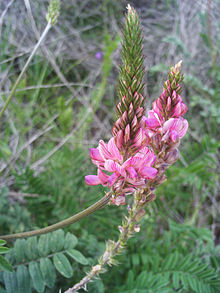- Onobrychis viciifolia
-
Onobrychis viciifolia 
Scientific classification Kingdom: Plantae (unranked): Angiosperms (unranked): Eudicots (unranked): Rosids Order: Fabales Family: Fabaceae Subfamily: Faboideae Genus: Onobrychis Species: O. viciifolia Binomial name Onobrychis viciifolia
Scop.Synonyms Hedysarum onobrychis
Onobrychis sativaOnobrychis viciifolia is a species of legume known by the common name sainfoin; other species in genus Onobrychis may be known by this name as well. Other common names for this species include esparcet and pipirigallo. This is a perennial herb which is native to Eurasia, but it is widely cultivated worldwide as an animal forage and fodder. It is also used to attract honeybees.
The plant grows up to about 80 centimeters in maximum height with an erect, hollow stem. It produces tall, showy spikelike racemes of pink pealike flowers each about a centimeter long. The leaves are divided into pairs of red-dotted green oval leaflets up to 2.5 centimeters long. The fruit is a net-textured, leathery legume pod 6 or 7 millimeters long containing one seed.
Common cultivars of this agricultural crop plant include 'Melrose', 'Othello', 'Vala', and 'Zeus'.[1] It is grown for grazing, hay, and silage, as it is relatively high in protein and most minerals. Its tannin content has also been shown to reduce the nematode load in the guts of lambs.[2] Planting it alongside timothy, wheatgrass, and other grasses reduces weed invasion.[1] Like other legumes this plant fixes nitrogen, but generally less efficiently than does alfalfa.[1] The plant is favored by honeybees and other pollinators because it produces large amounts of nectar and pollen.[3]
References
- ^ a b c FAO Crop Profile
- ^ Heckendorn, F., et al. (2006). Effect of sainfoin (Onobrychis viciifolia) silage and hay against gastrointestinal nematodes in lambs. Veterinary Parasitology 142 293-300.
- ^ Legumes & Some Relatives: Sainfoin
External links
Categories:- Faboideae stubs
- Faboideae
- Forages
Wikimedia Foundation. 2010.
